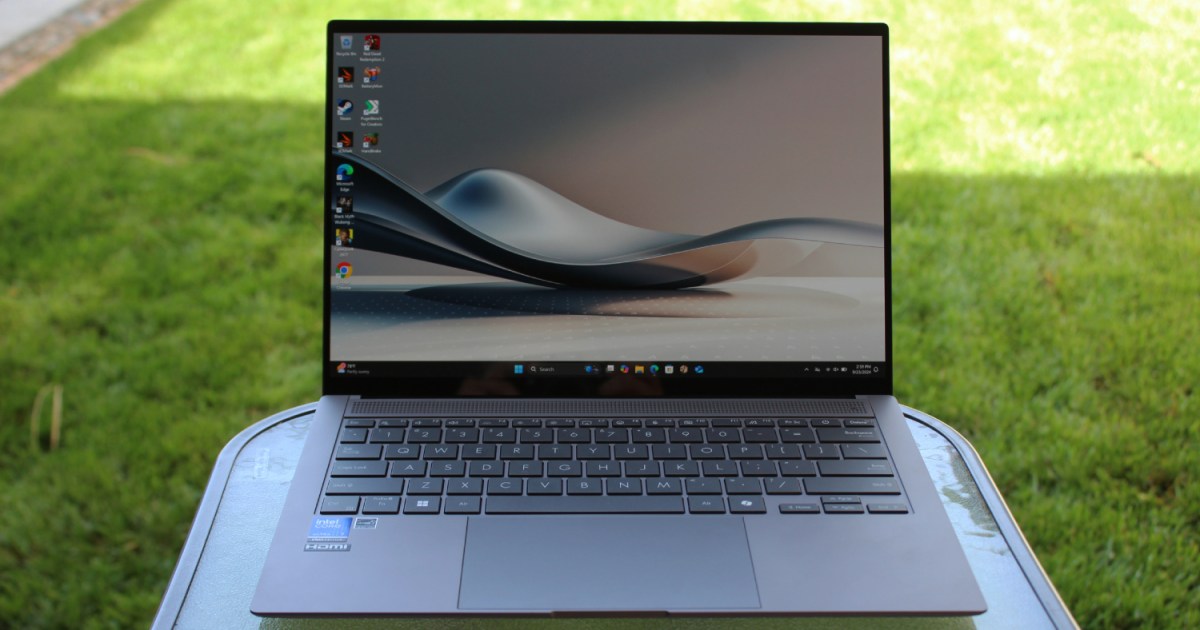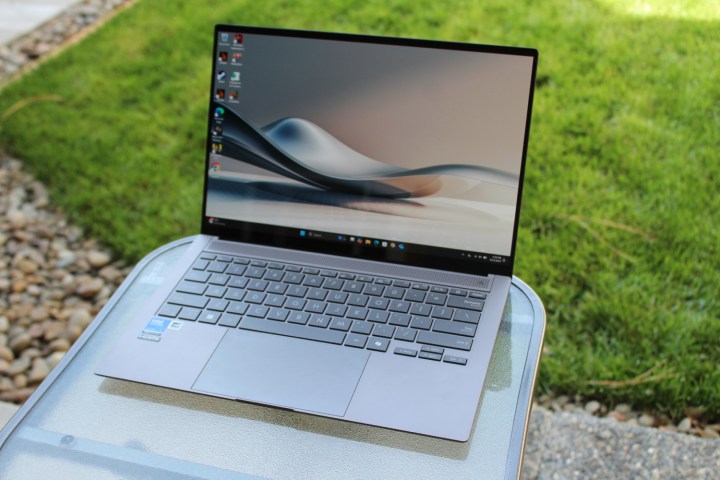 The Asus Zenbook S 14 in front of a grass lawn.A new era of Windows computing has arrived with Microsoft’s Copilot+ PC initiative and a trio of new chipsets: Qualcomm’s Snapdragon X, AMD’s Ryzen AI 300, and Intel’s Lunar Lake. While AI capabilities and NPU performance are generating buzz, the most significant advancements lie in overall performance and battery life – a crucial improvement for Windows laptops striving to compete with Apple’s efficient Silicon MacBooks. This article delves into the performance and efficiency of these new chipsets, highlighting Intel’s impressive strides in battery life.
The Asus Zenbook S 14 in front of a grass lawn.A new era of Windows computing has arrived with Microsoft’s Copilot+ PC initiative and a trio of new chipsets: Qualcomm’s Snapdragon X, AMD’s Ryzen AI 300, and Intel’s Lunar Lake. While AI capabilities and NPU performance are generating buzz, the most significant advancements lie in overall performance and battery life – a crucial improvement for Windows laptops striving to compete with Apple’s efficient Silicon MacBooks. This article delves into the performance and efficiency of these new chipsets, highlighting Intel’s impressive strides in battery life.
Performance Comparison of New Chipsets
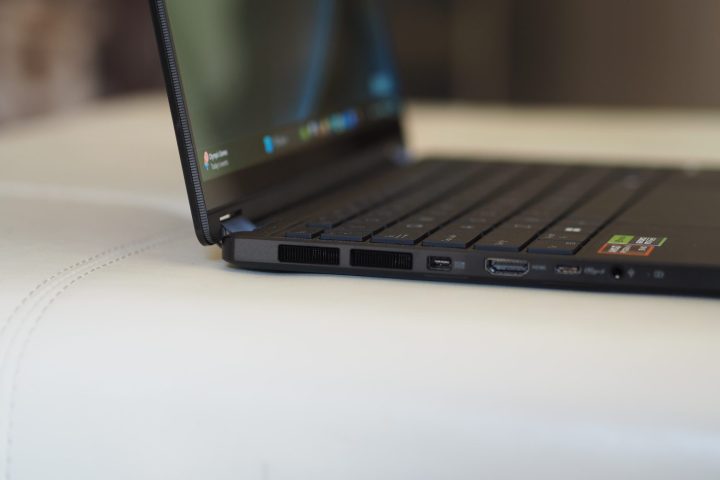 Asus ProArt PX13 side view showing ports and vents.Early benchmark results reveal intriguing insights. The focus here is on CPU performance, as integrated GPUs in these chipsets offer incremental improvements rather than substantial leaps compared to discrete GPUs like the Nvidia GeForce RTX 4050. Similarly, AI performance comparisons are omitted due to the lack of standardized benchmarks and the anticipated dominance of discrete GPUs in raw AI processing power.
Asus ProArt PX13 side view showing ports and vents.Early benchmark results reveal intriguing insights. The focus here is on CPU performance, as integrated GPUs in these chipsets offer incremental improvements rather than substantial leaps compared to discrete GPUs like the Nvidia GeForce RTX 4050. Similarly, AI performance comparisons are omitted due to the lack of standardized benchmarks and the anticipated dominance of discrete GPUs in raw AI processing power.
| Device | Cinebench R24 (Single/Multi) | Geekbench 6 (Single/Multi) | Handbrake | 3DMark Steel Nomad Light |
|---|---|---|---|---|
| Asus ExpertBook P5 (Core Ultra 7 258V / Intel Arc 140V) | 122 / 471 | 2679 / 10821 | 104 | 2636 |
| Asus Zenbook S 14 (Core Ultra 7 258V / Intel Arc 140V) | 112 / 452 | 2738 / 10734 | 113 | 3240 |
| HP OmniBook X (Snapdragon X Elite / Adreno) | 101 / 749 | 2377 / 13490 | N/A | 1953 |
| Asus Vivobook S 15 (Snapdragon X Plus / Adreno) | 108 / 724 | 2417 / 11319 | N/A | 1137 |
| Asus ProArt PX13 (Ryzen AI 9 HX 370 / RTX 4050) | 116 / 897 | 2710 / 14696 | 54 | 7648 |
| Asus Zenbook 14 Q425 (Core Ultra 7 155H / Intel Arc) | 103 / 631 | 2279 / 11806 | 82 | N/A |
| Lenovo ThinkPad X1 2-in-1 (Core Ultra 7 155U / Intel Arc) | 97 / 517 | 2103 / 8558 | 101 | 1523 |
| MacBook Air (M3) | 141 / 601 | 3102 / 12078 | 109 | 3378 |
Currently, AMD’s Ryzen AI 9 HX 370 leads in multi-core performance, followed closely by Qualcomm’s Snapdragon X Elite. Intel’s Core Ultra 7 285V, a low-power Lunar Lake variant, trails in performance but excels in efficiency.
Chipset Specifications and Configurations
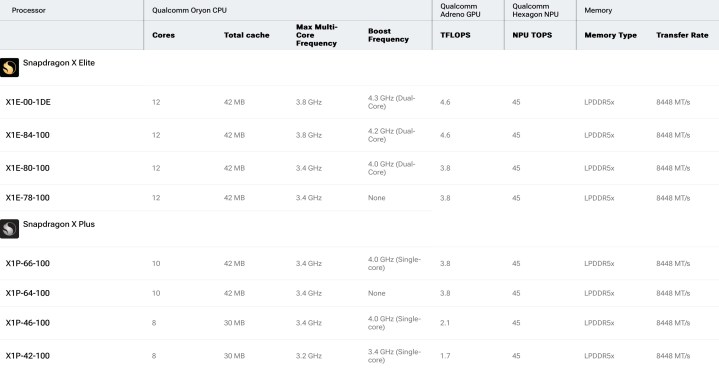 Qualcomm Snapdragon X chipset specs table listing various details about different variants.
Qualcomm Snapdragon X chipset specs table listing various details about different variants.
The Ryzen AI 9 HX 370, a 12-core, 24-thread processor with a configurable TDP between 15W and 54W, boasts impressive clock speeds of up to 5.1GHz. Qualcomm’s Snapdragon X series offers various configurations, with TDPs ranging from 23W to 45W (up to 80W for the X Elite). Intel’s Lunar Lake chipsets, ranging from Core Ultra 5 and 7 Series 2 (17W base TDP) to Core Ultra 9 Series 2 (30W base TDP), are configurable between 17W and 37W. Apple’s M3, a benchmark for performance and efficiency, comes in 8-core CPU/8-core GPU and 8-core CPU/10-core GPU versions.
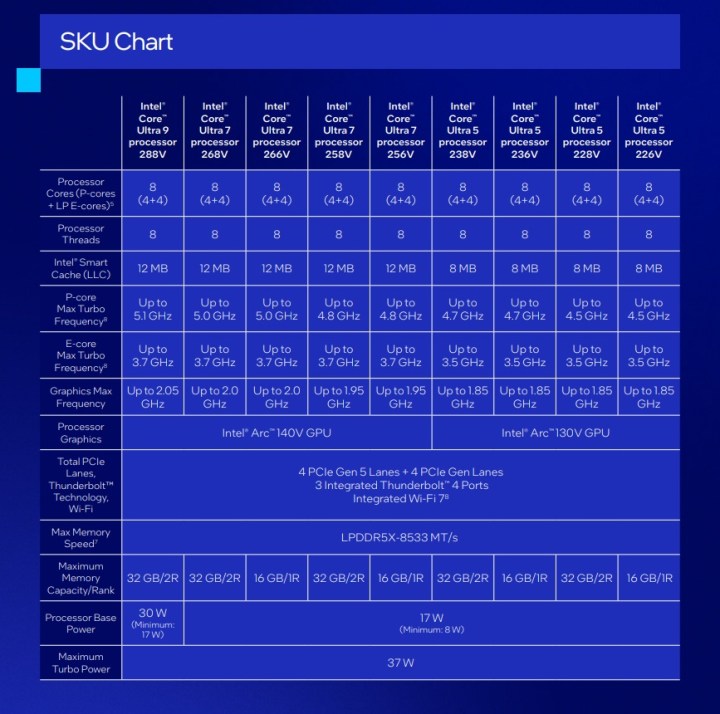 The Intel Core Ultra 200V series SKUs chart.
The Intel Core Ultra 200V series SKUs chart.
Battery Life: Intel Lunar Lake Emerges as a Winner
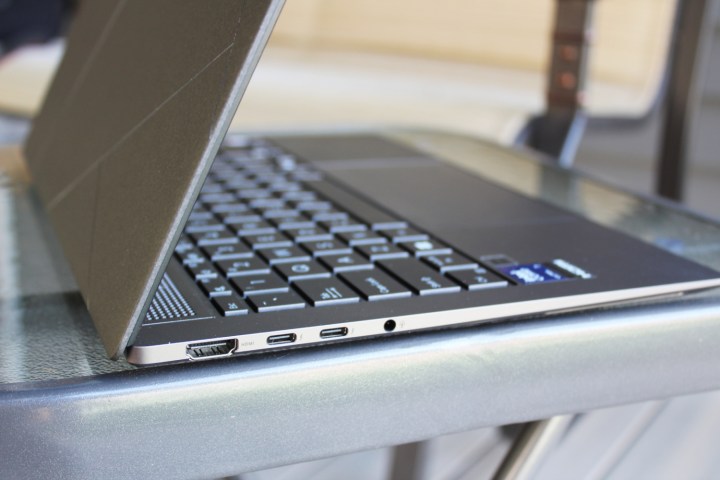 The ports shown on the left side of the Asus Zenbook S 14.
The ports shown on the left side of the Asus Zenbook S 14.
Efficiency is paramount, and Intel’s Lunar Lake makes significant strides. Preliminary data suggests that Lunar Lake outperforms Qualcomm’s Snapdragon X in battery life, though Apple’s M3 retains its leading position.
| Device | Web Browsing | Video Playback | Cinebench R24 |
|---|---|---|---|
| Asus Zenbook S 14 (Core Ultra 7 258V) | 16 hours, 47 minutes | 18 hours, 35 minutes | 3 hours, 33 minutes |
| Asus ExpertBook P5 (Core Ultra 7 258V) | 8 hours, 54 minutes | 16 hours, 29 minutes | 2 hours, 15 minutes |
| HP Omnibook X (Snapdragon X Elite) | 13 hours, 37 minutes | 22 hours, 4 minutes | 1 hour, 52 minutes |
| Asus Vivobook S 15 (Snapdragon X Plus) | 13 hours, 10 minutes | 16 hours, 19 minutes | N/A |
| Asus ProArt PX13 (Ryzen AI 9 HX 370) | 8 hours, 7 minutes | 11 hours, 12 minutes | 1 hour, 12 minutes |
| HP Spectre x360 14 (Core Ultra 7 155H) | 8 hours, 6 minutes | 13 hours, 3 minutes | N/A |
| Asus Zenbook S 14 (Core Ultra 7 155U) | 8 hours, 45 minutes | 12 hours, 25 minutes | N/A |
| Apple MacBook Air (Apple M3) | 19 hours, 38 minutes | 19 hours, 39 minutes | 3 hours, 27 minutes |
The Asus Zenbook S 14, equipped with the Intel Core Ultra 7, demonstrates exceptional battery life across various workloads, including web browsing and the demanding Cinebench R24 benchmark. While Qualcomm remains efficient under light loads, Intel’s Lunar Lake delivers consistent performance and extended battery life, marking a significant advancement for Windows laptops.
Conclusion: A Promising Future for Windows Laptops
While further testing and analysis are necessary as more laptops featuring these chipsets are released, Intel’s Lunar Lake presents a compelling improvement in battery life for Windows devices. This advancement, coupled with ongoing developments in performance and AI capabilities, signifies a positive trajectory for Windows laptops as they compete with Apple’s offerings.



